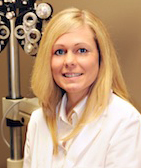Sponsored Content

By Tammy Tully, OD
May 19, 2021
As eye doctors, our most important job is to protect patients—from cradle to grave—against every conceivable vision and ocular disease or disability. As primary eyecare providers, we have to be on the lookout for the earliest changes that could threaten our patient’s vision.
The protocols we follow are generally well defined and, after a few years in practice, most of us become quite skilled at keeping our patients healthy and satisfied. But it is important to recognize that time does not stand still. Protocols change. New treatments and technologies generate updated and improved standards. The most poignant example of this is in how age-related macular degeneration (AMD) paradigms have shifted in recent years, particularly in terms of optometry’s expanded role.
Let’s Practice in the Present
AMD is the leading cause of irreversible legal blindness, affecting at least one-in-10 adults age 60 and over1 (that we are identifying). And at long last, we are in a position to do something about it. A little over a decade ago, a study revealed that 69 percent of patients were unaware that they had AMD before they were diagnosed with late-stage disease.2,3 But with today’s improved testing, optometrists can empower and help protect their patients. For example, we now know that behavior modification, nutritional supplementation and prompt anti-VEGF treatment can limit irreversible vision loss.4 Knowing this, we must embrace our responsibility to more closely monitor patients for changes and provide essential patient education and counseling throughout the entire continuum of this disease. Of course, none of this would have been possible without the commercialization and rapid adoption of dark adaptation (DA) testing.
Before DA testing became practical and mainstream, detecting AMD was challenging. In fact, observing the macula and evaluating fundus photos for small drusen and pigmentary changes resulted in missed diagnoses about 25 percent of the time.5 Even in clinical trials, visual acuity (VA) was used as the primary endpoint for AMD6 —though researchers were well aware that VA has significant limitations because it’s generally stable in the earlier stages of the disease.7,8 Night vision, on the other hand, is often affected earlier in the disease process.9, 10, 11, 12 This knowledge led researchers to turn their attention to DA, which now has been shown— time and again — to be a functional biomarker for AMD progression.13, 14 Furthermore, cross-sectional analyses demonstrate that DA is associated with increasing AMD severity and worsens over time in patients with AMD.15
Our New AMD Standard of Care
Dark adaptation testing with the AdaptDx or the AdaptDx Pro (the only two commercially available dark adaptometers) provides an objective output (Rod-Intercept Time, RI) that is 90 percent sensitive to the presence of AMD.16 Having this level of confidence makes adoption simple to justify, yet many optometrists wondered how to practically implement the technology in practice— and I am no exception. In fact, when we first got our device, we only tested patients with night vision complaints. But after two years using this testing model, we wondered: were we missing AMD? And, if so, at what cost to our patients and our practice?
We decided to investigate further by implementing a new standard of care: every patient over 50 was tested on the day of their exam, no matter what.
Other Articles to Explore
After comparing 2018 data using our original testing model, to data from the same months in 2019 with our new “everyone-over-50” standard of care, it was clear we had made the right decision. The difference was staggering. Dark adaptation testing increased from 17 to 63 per month, an increase of 270 percent. As a result, dark adaptation testing helped identify AMD patients in our practice who receive additional care, testing, imaging and supplements that generates nearly $10,000 in monthly revenue.
These numbers validated our new approach: testing everyone over 50 was the right thing to do. We were finding early AMD, which was great for our patients, but we were also increasing revenue for the practice.
There Is No Turning Back
A lot can change in the 12 to 18 months between comprehensive exams, especially for our aging patients. As an optometrist, I sleep better at night knowing that I’m able to find AMD as early as possible to give my patients the education they need to take action to preserve their vision. And as a practice owner, having the technology to provide the most comprehensive medical care to my AMD patients allows me to do right by both my patients and my practice.
References
1 Jackson GR, Scott IU, Kim IK, Quillen DA, Iannaccone A, Edwards JG. Diagnostic sensitivity and specificity of dark adaptometry for detection of age-related macular degeneration. Invest Ophthalmol Vis Sci. 2014;55(3):1427-1431. Published 2014 Mar 10. doi:10.1167/iovs.13-13745
2 Jackson GR, Scott IU, Kim IK, Quillen DA, Iannaccone A, Edwards JG. Diagnostic sensitivity and specificity of dark adaptometry for detection of age-related macular degeneration. Invest Ophthalmol Vis Sci. 2014;55(3):1427-1431. Published 2014 Mar 10. doi:10.1167/iovs.13-13745
3 Cervantes-Casta˜neda RA, Banin E, Hemo I, Shpigel M, Averbukh E, Chowers I. Lack of benefit of early awareness to age-related macular degeneration. Eye. 2007;22:777–781.
4 Jackson GR, Scott IU, Kim IK, Quillen DA, Iannaccone A, Edwards JG. Diagnostic sensitivity and specificity of dark adaptometry for detection of age-related macular degeneration. Invest Ophthalmol Vis Sci. 2014;55(3):1427-1431. Published 2014 Mar 10. doi:10.1167/iovs.13-13745
5 Neely DC. JAMA Ophthalmol. 2017;135(6):570-575.
6 Csaky KG, Richman EA, Ferris 3rd FL. Report from the NEI/FDA Ophthalmic Clinical Trial Design and Endpoints Symposium. Invest Ophthalmol Vis Sci. 2008;49:479e489.
7 Chen KG, Alvarez JA, Yazdanie M, et al. Longitudinal Study of Dark Adaptation as a Functional Outcome Measure for Age-Related Macular Degeneration. Ophthalmology. 2019;126(6):856-865. doi:10.1016/j.ophtha.2018.09.039
8 Owsley C, Huisingh C, Clark ME, et al. Comparison of visual function in older eyes in the earliest stages of age-related macular degeneration to those in normal macular health. Curr Eye Res. 2015:1e7.
9 Chen KG, Alvarez JA, Yazdanie M, et al. Longitudinal Study of Dark Adaptation as a Functional Outcome Measure for Age-Related Macular Degeneration. Ophthalmology. 2019;126(6):856-865. doi:10.1016/j.ophtha.2018.09.039
10 Scilley K, Jackson GR, Cideciyan AV, et al. Early age-related maculopathy and self-reported visual difficulty in daily life. Ophthalmology. 2002;109:1235e1242.
11 Owsley C, McGwin G, Jackson GR, et al. Effect of short-term, high-dose retinol on dark adaptation in aging and early age-related maculopathy. Invest Ophthalmol Vis Sci. 2006;47:1310e1318.
12 Ying GS, Maguire MG, Liu C, Antoszyk AN; Complications of Age-related Macular Degeneration Prevention Trial
Research Group. Night vision symptoms and progression of age-related macular degeneration in the Complications of Age-related Macular Degeneration Prevention Trial. Ophthalmology. 2008;115:1876e1882.
13 Chen KG, Alvarez JA, Yazdanie M, et al. Longitudinal Study of Dark Adaptation as a Functional Outcome Measure for Age-Related Macular Degeneration. Ophthalmology. 2019;126(6):856-865. doi:10.1016/j.ophtha.2018.09.039
14 Owsley C, Huisingh C, Clark ME, et al. Comparison of visual function in older eyes in the earliest stages of age-related macular degeneration to those in normal macular health. Curr Eye Res. 2015:1e7.
15 Chen KG, Alvarez JA, Yazdanie M, et al. Longitudinal Study of Dark Adaptation as a Functional Outcome Measure for Age-Related Macular Degeneration. Ophthalmology. 2019;126(6):856-865. doi:10.1016/j.ophtha.2018.09.039
16 Owsley C, Jackson GR, White M, Feist R, Edwards D. Delays in rod-mediated dark adaptation in early age-related maculopathy. Ophthalmology. 2001; 108:1196–202.
 Tammy Tully, OD, is the owner of Vision Source at Seaside Eye Associates in Myrtle Beach, S.C. To contact her: tttully@aim.com
Tammy Tully, OD, is the owner of Vision Source at Seaside Eye Associates in Myrtle Beach, S.C. To contact her: tttully@aim.com

























